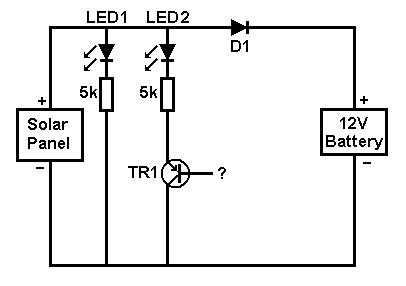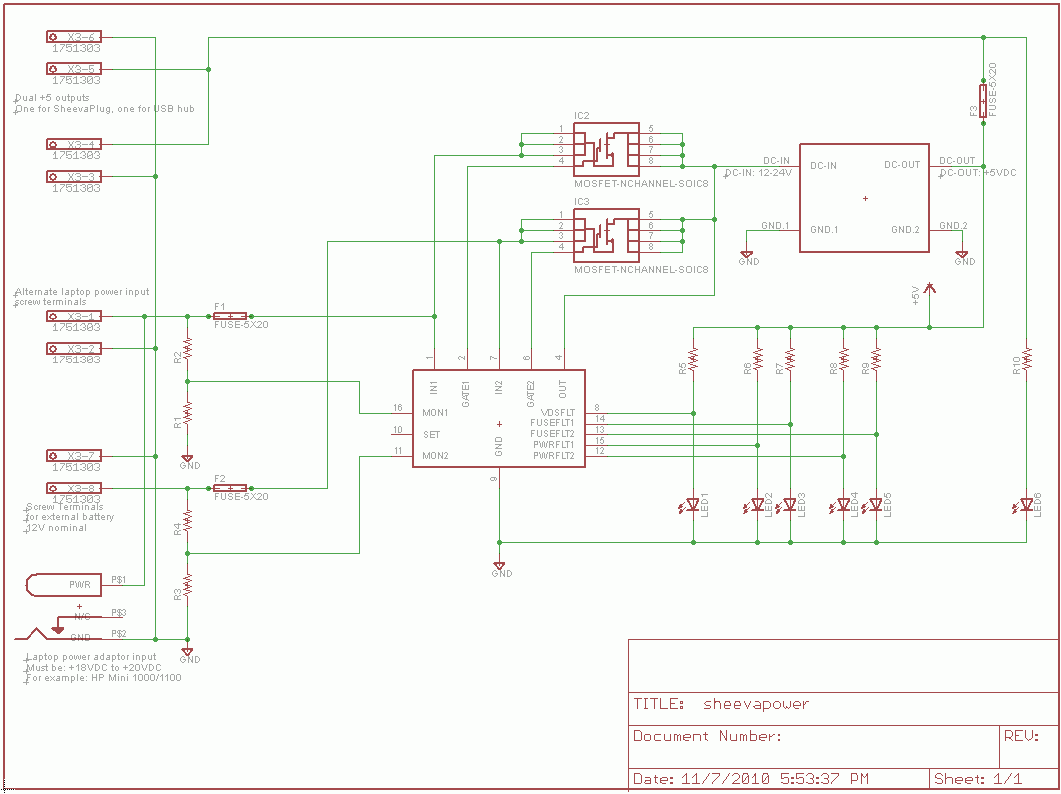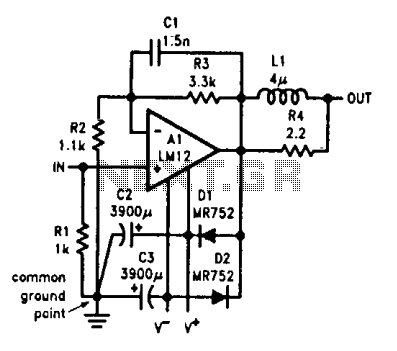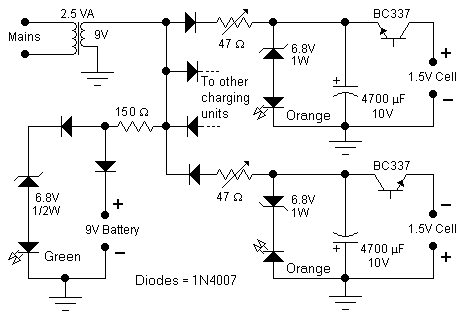
Bipolar power supply for battery instruments
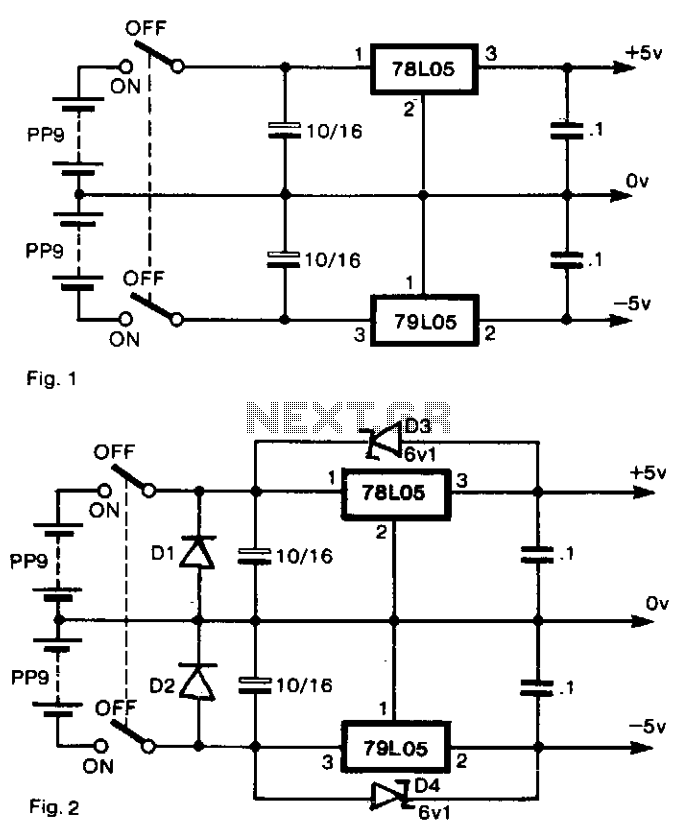
To generate regulated ±5-V supplies from a pair of dry batteries, the circuit shown in Fig. 1 is commonly utilized. To protect against inadvertent reverse connection of a battery, a diode in series with each battery would create an unacceptable voltage drop. A more effective solution is to use diodes D1 and D2 in parallel with each battery, as illustrated in Fig. 2. When the supply is turned off, there is a risk of reverse bias being applied across the regulators if there is significant inductance or capacitance in the load circuit. Diodes placed across the regulators prevent damage. When the power supply is activated, the two switches may not operate simultaneously, leading to the possibility that one regulator could be latched off by the other. To mitigate this issue, D3 and D4 are Zener diodes, ensuring that the ±5-V rails are maintained by the batteries until the regulators can establish the correct voltage levels.
The circuit described is designed to provide dual regulated ±5-V outputs from a pair of dry batteries, which is particularly useful in applications requiring a stable voltage supply. The implementation of diodes D1 and D2 in parallel with the batteries serves as a protective measure against reverse polarity connections; this configuration allows current to bypass the batteries in the event of incorrect connection without incurring the voltage drop typically associated with series diodes.
In the circuit, the use of Zener diodes D3 and D4 is critical for maintaining the output voltage levels during the power-up sequence. These diodes ensure that the output rails are pulled up to the battery voltage until the linear regulators can stabilize the output at ±5 V. This approach prevents any potential latch-up conditions that may arise from the asynchronous activation of the regulators.
The design also accounts for the inductive or capacitive loads that may be present in the output circuit. If the load exhibits significant inductance or capacitance, turning off the supply could inadvertently apply a reverse bias to the regulators, potentially leading to damage. The inclusion of protective diodes across the regulators effectively mitigates this risk by providing a safe path for any reverse current that may occur during transient conditions.
Overall, this circuit configuration is a robust solution for generating regulated dual voltage supplies from dry batteries, with built-in protections to ensure reliable operation in various conditions. The careful selection of components, including the placement of Zener diodes and parallel diodes, contributes to the overall reliability and effectiveness of the power supply circuit.To generate regulated ± 5-V supplies from a pair of dry batteries, the circuit of Fig. 1 is commonly used. In order to give protection from inadvertent reverse connection of a battery, a diode in series with each battery would produce an unacceptable voltage drop. The more effective approach is to fit diodes Dl and D2 as shown in Fig. 2, in parallel with each battery. When the supply is switched off, there is the risk of a reverse bias being applied across the regulators, if there is significant inductance or capacitance in the load circuit.
Diodes across the regulators prevent damage. When the power supply is switched on, the two switches do not act in unison. There is a probability that one or the other regulators will be latched hard off by the other. To prevent this, D3 and D4 are Zener diodes so that ± 5-V rails are pulled up by the batteries until the regulators establish the correct levels.
The circuit described is designed to provide dual regulated ±5-V outputs from a pair of dry batteries, which is particularly useful in applications requiring a stable voltage supply. The implementation of diodes D1 and D2 in parallel with the batteries serves as a protective measure against reverse polarity connections; this configuration allows current to bypass the batteries in the event of incorrect connection without incurring the voltage drop typically associated with series diodes.
In the circuit, the use of Zener diodes D3 and D4 is critical for maintaining the output voltage levels during the power-up sequence. These diodes ensure that the output rails are pulled up to the battery voltage until the linear regulators can stabilize the output at ±5 V. This approach prevents any potential latch-up conditions that may arise from the asynchronous activation of the regulators.
The design also accounts for the inductive or capacitive loads that may be present in the output circuit. If the load exhibits significant inductance or capacitance, turning off the supply could inadvertently apply a reverse bias to the regulators, potentially leading to damage. The inclusion of protective diodes across the regulators effectively mitigates this risk by providing a safe path for any reverse current that may occur during transient conditions.
Overall, this circuit configuration is a robust solution for generating regulated dual voltage supplies from dry batteries, with built-in protections to ensure reliable operation in various conditions. The careful selection of components, including the placement of Zener diodes and parallel diodes, contributes to the overall reliability and effectiveness of the power supply circuit.To generate regulated ± 5-V supplies from a pair of dry batteries, the circuit of Fig. 1 is commonly used. In order to give protection from inadvertent reverse connection of a battery, a diode in series with each battery would produce an unacceptable voltage drop. The more effective approach is to fit diodes Dl and D2 as shown in Fig. 2, in parallel with each battery. When the supply is switched off, there is the risk of a reverse bias being applied across the regulators, if there is significant inductance or capacitance in the load circuit.
Diodes across the regulators prevent damage. When the power supply is switched on, the two switches do not act in unison. There is a probability that one or the other regulators will be latched hard off by the other. To prevent this, D3 and D4 are Zener diodes so that ± 5-V rails are pulled up by the batteries until the regulators establish the correct levels.
